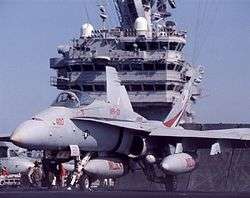VFA-131
| Strike Fighter Squadron 131 | |
|---|---|
 VFA-131 Insignia | |
| Active | 2 October 1983 - present |
| Country | United States of America |
| Branch |
|
| Type | Fighter/Attack |
| Role |
Close air support Air interdiction Aerial reconnaissance |
| Part of | Carrier Air Wing 3 |
| Garrison/HQ | NAS Oceana |
| Nickname(s) | "Wildcats" |
| Motto(s) | "Airlant's First and Finest" |
| Colors | Red, white, blue |
| Engagements |
Gulf War Operation Deny Flight Operation Southern Watch Operation Decisive Endeavor Operation Enduring Freedom Iraq War |
| Aircraft flown | |
| Fighter | F/A-18 Hornet |
Strike Fighter Squadron 131 (VFA-131), also known as the "Wildcats", is a United States Navy F/A-18C Hornet fighter squadron stationed at Naval Air Station Oceana. Their radio call sign alternates between "Cat" and "Cougar" and their aircraft tail code is AG.
Mission
The mission of VFA-131 is combat readiness as a part of U.S. Atlantic Fleet Carrier Strike Forces, utilizing the F/A-18 aircraft to project power ashore and at sea, to defend the fleet against air and sea threats and to carry out all other missions which may be assigned by cognizant authority.
Squadron Insignia and Nickname
The squadron’s insignia was approved by Chief of Naval Operations on 26 January 1984.
History
1980s
VFA-131 was established at Naval Air Station Lemoore, California, on 2 October 1983, and trained in the F/A-18 Hornet under VFA-125. The squadron received their first F/A-18A in May 1984. In January 1985, the squadron moved to Naval Air Station Cecil Field, Florida, becoming the Atlantic Fleet’s first F/A-18 squadron.[1]
As a part of Carrier Air Wing 13 (CVW-13), the squadron deployed to the Mediterranean Sea in October 1985 aboard USS Coral Sea.
In March 1986 during Freedom of Navigation exercises in the Gulf of Sidra, the squadron’s aircraft flew Combat Air Patrols during which a Libyan SA-5 Gammon missile was fired against an American aircraft operating in international waters. On 14–15 April 1986, squadron aircraft participated in Operation El Dorado Canyon, along with other units of CVW-13 and A-7s from CVW-1, providing air-to-surface Shrike and HARM strikes against Libyan surface-to-air missile sites at Benghazi. This was the first use of the F/A-18 in combat.
In October 1988, the squadron joined Carrier Air Wing 7 and deployed to the Mediterranean Sea aboard USS Coral Sea. In August 1990 aboard the USS Dwight D. Eisenhower, they were among the units to respond to the Iraqi invasion of Kuwait as part of Operation Desert Shield.[1]
VFA-131 embarked on USS Independence from 15 August–8 October 1988 for the carrier’s transit from Naval Station Norfolk to its new home port at NAS North Island via Cape Horn.
1990s

In August 1990 while embarked on USS Dwight D. Eisenhower, squadron F/A-18s flew missions in the Red Sea in support of Operation Desert Shield, the build-up of American and Allied forces to counter a threatened invasion of Saudi Arabia by Iraq and as part of an economic blockade of Iraq to force its withdrawal from Kuwait. The Eisenhower task force was the first U.S. force in position to deter Iraqi incursion into Saudi Arabia.
Upon return from deployment in September 1990, the squadron transitioned to F/A-18C Lot XIII Night Strike Hornets. One year later, the squadron again deployed aboard USS Dwight D. Eisenhower to the Red Sea and North Persian Gulf in support of Operation Desert Storm.
In May 1994, the squadron was part of the maiden deployment of the USS George Washington. They flew sorties in support of Operation Deny Flight over Bosnia-Herzegovina and Operation Southern Watch over southern Iraq. In October 1994, they returned to the Persian Gulf and participated in Operation Vigilant Warrior, in response to Iraqi aggression.[1]
In April 1996 the squadron once again deployed aboard USS George Washington to the Mediterranean, Adriatic Sea, and the Persian Gulf in support of Operation Decisive Endeavor and Operation Southern Watch. In February 1998, the squadron deployed for the “Around the World”, maiden deployment of USS John C. Stennis, again supporting Operation Southern Watch in Iraq. Upon return to the United States in December 1998, they relocated from NAS Cecil Field, Florida, to NAS Oceana, Virginia.
2000s
On September 11, 2001, the squadron was underway aboard USS John F. Kennedy off the Virginia Capes. Within hours of the September 11 attacks, armed squadron Hornets were conducting air patrols over Washington D.C. and New York City as part of Operation Noble Eagle. In February 2002, the squadron deployed to the North Arabian Sea to take part in Operation Enduring Freedom (OEF), flying combat sorties over Afghanistan.
From January to July 2004, VFA-131 deployed aboard USS George Washington in support of Operation Iraqi Freedom. The squadron deployed from October 2006 to June 2007 aboard USS Dwight D. Eisenhower in support of OIF, OEF, and operations in Somalia.
References
See also
- Naval aviation
- Modern US Navy carrier air operations
- List of United States Navy aircraft squadrons
- List of inactive United States Navy aircraft squadrons
